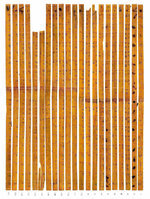Ancient Chinese used bamboo sticks as calculator
Approximately 2,300 years ago the ancient Chinese wrote the world's oldest decimal multiplication table on bamboo sticks. According to experts, it was a very effective calculator that let one do the calculations not only with integers but also fractions. No country in the world had similar calculators at that time.
Five years ago, Beijing Tsinghua University received a gift of nearly two and a half thousand dirty and moldy bamboo sticks. Most likely, they were found by raiders of ancient tombs and then sold at a market in Hong Kong. According to radiocarbon analysis, this artifact was created in about 305 BC, which corresponds to China's Warring States period.
Despite the military conflicts, this historical period (481, 475 or 453-221 BC) is characterized by flourishing trade and commerce, spread of iron tools, construction of large irrigation projects, development of agriculture, and population growth. At that time groups of educated citizens professionally engaged in intellectual work have emerged. The Warring States period is often identified with the "golden age" of Chinese philosophy. This period immediately preceded the formation of the Qin Empire.

According to the information on Nature portal, each strip is 12.7 mm wide and up to half a meter long. From top to bottom they are covered with ancient writing. According to Chinese historians, this important artifact has 65 ancient texts written in black ink. Due to the fact that the threads connecting pages into a single manuscript scroll have decayed, and some bamboo sticks have disappeared and others have been broken, the transcript of texts turned into a real puzzle for the researchers.
Scientists noticed a "canvas" consisting of 21 bamboo strips inscribed only with numbers. As suggested by Chinese mathematicians, it was the oldest known multiplication tables in the world. When the strips are placed properly, one will notice that the top line and the rightmost column contain the same 19 numbers arranged from right to left and top to bottom, respectively: 0.5, integers from one to nine, and the numbers dividable by 10, from 10 to 90.
Like in modern decimal multiplication table, the numbers at the intersection of each row and column are the results of multiplication of relevant numbers. The table can also be used to multiply any integer or integer and a half from 0.5 to 99.5. According to a working version, the numbers not represented in the table first have to be broken down into components. For example, 22.5 × 35.5 can be transformed as follows: (20 + 2 + 0.5) x ( 30 + 5 + 0.5 ). To solve this problem one should perform nine multiplications 20 × 30, 20 × 5 20 × 0.5, 2 × 30 and so on. The end result will be the sum of these results. This is quite an effective ancient calculator.
Science historians note the antiquity of Chinese mathematical practice, but are quite careful in the description of the mathematical theory of the ancient Chinese. Among the earliest known Chinese mathematical treatises there are "The Arithmetical Classic of the Gnomon" (Zhou Bi Suan Jing) and "Mathematical treatise in nine sections " (Chiu Chang Suan Shu) that date back to 5-2 and 3-1 centuries BC, respectively. Some scientists mention possible contacts of Chinese mathematicians with Indian ones, but it happened much later, in 5-7 century.
Likely the discovered multiplication table was used by Chinese officials to calculate the area of land, counting crop yields or taxes. This calculator can also be used for division and extracting square roots. However, modern scientists are not sure whether such complex operations were performed in that era. In any event, according to the historian of mathematics at New York University Joseph Dauben, this is the earliest artifact of a decimal multiplication table in the world.
The American scientist is confident that the ancient Chinese used complex arithmetic in theoretical and commercial purposes in the era of the Warring States. This happened before the first emperor Ying Zheng who unified the entire China and took the title of Qin Shi Huang (first Huang of the Qin Dynasty). Later, he ordered to burn many books and banned private libraries in an attempt to reverse the country's intellectual tradition.
Until now, a text dating back to the Qin Dynasty (221-206 years BC) was considered the oldest Chinese multiplication table. It is a series of short sentences, for example, "six eight forty eight." It contained only the simplest multiplications. Multiplication tables of ancient Babylon are much older. They are approximately 4,000 years old, but a set of tables used for multiplication was bulky, with separate tables for multiplication by 1-20, 30 ... 50
No calculations were possible without a large library of tables in Babylon. Furthermore, they did not have a decimal multiplication table. In Europe the first multiplication tables appeared only during the Renaissance era.
Igor Bukker
Pravda.Ru
Subscribe to Pravda.Ru Telegram channel, Facebook, RSS!




